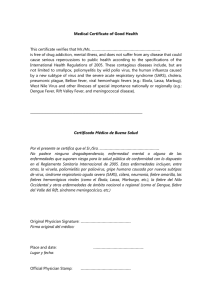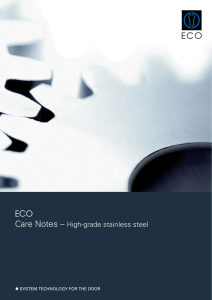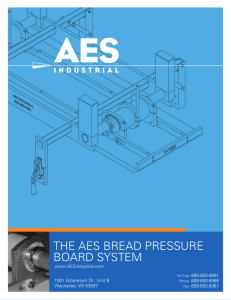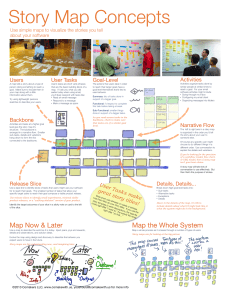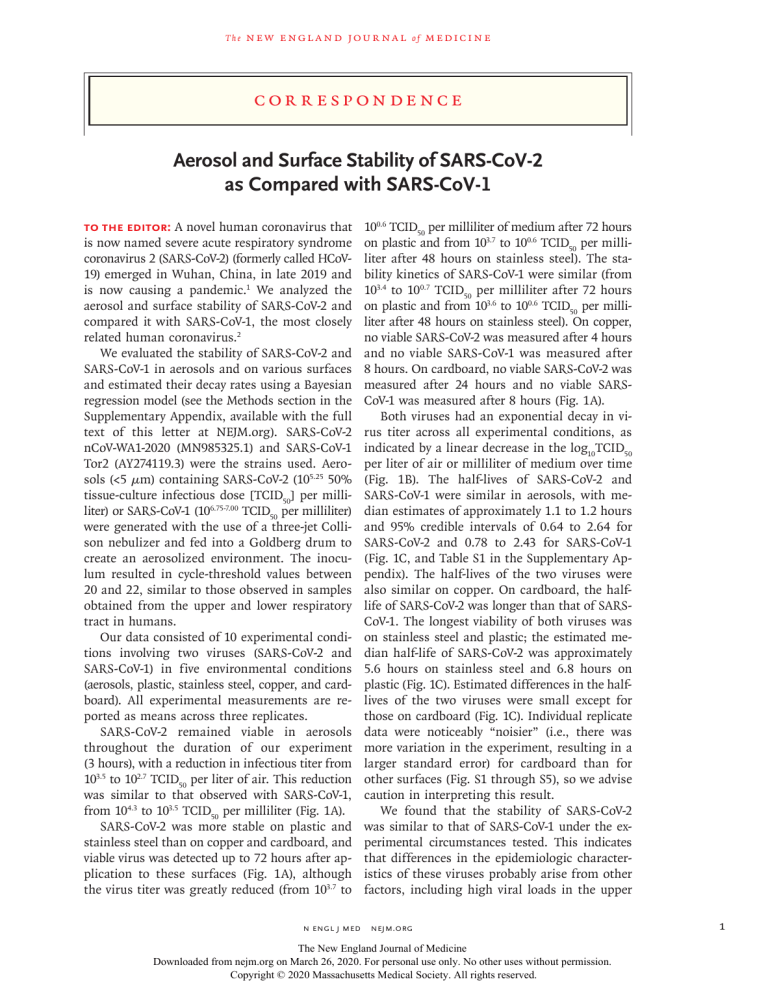
The n e w e ng l a n d j o u r na l of m e dic i n e C or r e sp ondence Aerosol and Surface Stability of SARS-CoV-2 as Compared with SARS-CoV-1 To the Editor: A novel human coronavirus that is now named severe acute respiratory syndrome coronavirus 2 (SARS-CoV-2) (formerly called HCoV19) emerged in Wuhan, China, in late 2019 and is now causing a pandemic.1 We analyzed the aerosol and surface stability of SARS-CoV-2 and compared it with SARS-CoV-1, the most closely related human coronavirus.2 We evaluated the stability of SARS-CoV-2 and SARS-CoV-1 in aerosols and on various surfaces and estimated their decay rates using a Bayesian regression model (see the Methods section in the Supplementary Appendix, available with the full text of this letter at NEJM.org). SARS-CoV-2 nCoV-WA1-2020 (MN985325.1) and SARS-CoV-1 Tor2 (AY274119.3) were the strains used. Aerosols (<5 μm) containing SARS-CoV-2 (105.25 50% tissue-culture infectious dose [TCID50] per milliliter) or SARS-CoV-1 (106.75-7.00 TCID50 per milliliter) were generated with the use of a three-jet Collison nebulizer and fed into a Goldberg drum to create an aerosolized environment. The inoculum resulted in cycle-threshold values between 20 and 22, similar to those observed in samples obtained from the upper and lower respiratory tract in humans. Our data consisted of 10 experimental conditions involving two viruses (SARS-CoV-2 and SARS-CoV-1) in five environmental conditions (aerosols, plastic, stainless steel, copper, and cardboard). All experimental measurements are reported as means across three replicates. SARS-CoV-2 remained viable in aerosols throughout the duration of our experiment (3 hours), with a reduction in infectious titer from 103.5 to 102.7 TCID50 per liter of air. This reduction was similar to that observed with SARS-CoV-1, from 104.3 to 103.5 TCID50 per milliliter (Fig. 1A). SARS-CoV-2 was more stable on plastic and stainless steel than on copper and cardboard, and viable virus was detected up to 72 hours after application to these surfaces (Fig. 1A), although the virus titer was greatly reduced (from 103.7 to 100.6 TCID50 per milliliter of medium after 72 hours on plastic and from 103.7 to 100.6 TCID50 per milliliter after 48 hours on stainless steel). The stability kinetics of SARS-CoV-1 were similar (from 103.4 to 100.7 TCID50 per milliliter after 72 hours on plastic and from 103.6 to 100.6 TCID50 per milliliter after 48 hours on stainless steel). On copper, no viable SARS-CoV-2 was measured after 4 hours and no viable SARS-CoV-1 was measured after 8 hours. On cardboard, no viable SARS-CoV-2 was measured after 24 hours and no viable SARSCoV-1 was measured after 8 hours (Fig. 1A). Both viruses had an exponential decay in virus titer across all experimental conditions, as indicated by a linear decrease in the log10TCID50 per liter of air or milliliter of medium over time (Fig. 1B). The half-lives of SARS-CoV-2 and SARS-CoV-1 were similar in aerosols, with median estimates of approximately 1.1 to 1.2 hours and 95% credible intervals of 0.64 to 2.64 for SARS-CoV-2 and 0.78 to 2.43 for SARS-CoV-1 (Fig. 1C, and Table S1 in the Supplementary Appendix). The half-lives of the two viruses were also similar on copper. On cardboard, the halflife of SARS-CoV-2 was longer than that of SARSCoV-1. The longest viability of both viruses was on stainless steel and plastic; the estimated median half-life of SARS-CoV-2 was approximately 5.6 hours on stainless steel and 6.8 hours on plastic (Fig. 1C). Estimated differences in the halflives of the two viruses were small except for those on cardboard (Fig. 1C). Individual replicate data were noticeably “noisier” (i.e., there was more variation in the experiment, resulting in a larger standard error) for cardboard than for other surfaces (Fig. S1 through S5), so we advise caution in interpreting this result. We found that the stability of SARS-CoV-2 was similar to that of SARS-CoV-1 under the experimental circumstances tested. This indicates that differences in the epidemiologic characteristics of these viruses probably arise from other factors, including high viral loads in the upper n engl j med nejm.org The New England Journal of Medicine Downloaded from nejm.org on March 26, 2020. For personal use only. No other uses without permission. Copyright © 2020 Massachusetts Medical Society. All rights reserved. 1 n engl j med 100 101 102 103 104 0 0.5 2.0 Hours 1.0 Aerosols 100 101 102 103 104 100 101 102 103 104 0 0 Hours 1.0 1.0 nejm.org The New England Journal of Medicine Downloaded from nejm.org on March 26, 2020. For personal use only. No other uses without permission. Copyright © 2020 Massachusetts Medical Society. All rights reserved. 3.0 3.0 40 60 80 0 20 40 60 80 0 0 4 SARS-CoV-2 SARS-CoV-1 0 2 4 6 8 8 6 10 10 Copper 100 100 102 102 101 103 103 101 104 104 100 0 20 40 60 80 40 60 80 100 101 102 103 104 100 0 2 4 6 8 10 Hours SARS-CoV-1 Cardboard 20 SARS-CoV-2 0 101 101 20 102 102 100 102 103 103 101 103 104 104 Hours 100 101 102 103 104 104 0 Cardboard 100 100 Copper 101 101 0 1 4 8 24 48 72 96 102 102 Cardboard 0 1 4 8 24 48 72 96 103 103 2 SARS-CoV-2 SARS-CoV-1 Aerosols 3.0 104 Copper 104 2 4 6 8 10 2.0 2.0 Aerosols C Half-Life of Viable Virus Titer (TCID50/liter of air) Titer (TCID50/liter of air) B Predicted Decay of Virus Titer Titer (TCID50/liter of air) A Titers of Viable Virus 40 40 60 60 80 80 SARS-CoV-1 Stainless Steel 20 20 SARS-CoV-2 0 0 Stainless Steel 0 1 4 8 24 48 72 96 Stainless Steel 0 2 4 6 8 10 100 101 102 103 104 100 101 102 103 104 100 101 102 103 104 20 20 40 40 60 60 80 80 SARS-CoV-1 Plastic SARS-CoV-2 0 0 Plastic 0 1 4 8 24 48 72 96 Plastic SARS-CoV-1 SARS-CoV-2 SARS-CoV-1 SARS-CoV-2 of Half-Life (hr) Titer (TCID50/ml of medium) Titer (TCID50/ml of medium) Titer (TCID50/ml of medium) 2 n e w e ng l a n d j o u r na l Half-Life (hr) The m e dic i n e Correspondence Figure 1 (facing page). Viability of SARS-CoV-1 and SARS-CoV-2 in Aerosols and on Various Surfaces. As shown in Panel A, the titer of aerosolized viable virus is expressed in 50% tissue-culture infectious dose (TCID50) per liter of air. Viruses were applied to copper, cardboard, stainless steel, and plastic maintained at 21 to 23°C and 40% relative humidity over 7 days. The titer of viable virus is expressed as TCID50 per milliliter of collection medium. All samples were quantified by end-point titration on Vero E6 cells. Plots show the means and standard errors (I bars) across three replicates. As shown in Panel B, regression plots indicate the predicted decay of virus titer over time; the titer is plotted on a logarithmic scale. Points show measured titers and are slightly jittered (i.e., they show small rapid variations in the amplitude or timing of a waveform arising from fluctuations) along the time axis to avoid overplotting. Lines are random draws from the joint posterior distribution of the exponential decay rate (negative of the slope) and intercept (initial virus titer) to show the range of possible decay patterns for each experimental condition. There were 150 lines per panel, including 50 lines from each plotted replicate. As shown in Panel C, violin plots indicate posterior distribution for the half-life of viable virus based on the estimated exponential decay rates of the virus titer. The dots indicate the posterior median estimates, and the black lines indicate a 95% credible interval. Experimental conditions are ordered according to the posterior median half-life of SARS-CoV-2. The dashed lines indicate the limit of detection, which was 3.33×10 0.5 TCID50 per liter of air for aerosols, 10 0.5 TCID50 per milliliter of medium for plastic, steel, and cardboard, and 101.5 TCID50 per milliliter of medium for copper. respiratory tract and the potential for persons infected with SARS-CoV-2 to shed and transmit the virus while asymptomatic.3,4 Our results indicate that aerosol and fomite transmission of SARS-CoV-2 is plausible, since the virus can remain viable and infectious in aerosols for hours and on surfaces up to days (depending on the inoculum shed). These findings echo those with SARS-CoV-1, in which these forms of transmission were associated with nosocomial spread and super-spreading events,5 and they provide information for pandemic mitigation efforts. Neeltje van Doremalen, Ph.D. Trenton Bushmaker, B.Sc. National Institute of Allergy and Infectious Diseases Hamilton, MT Dylan H. Morris, M.Phil. Princeton University Princeton, NJ Myndi G. Holbrook, B.Sc. National Institute of Allergy and Infectious Diseases Hamilton, MT Amandine Gamble, Ph.D. University of California, Los Angeles Los Angeles, CA Brandi N. Williamson, M.P.H. National Institute of Allergy and Infectious Diseases Hamilton, MT Azaibi Tamin, Ph.D. Jennifer L. Harcourt, Ph.D. Natalie J. Thornburg, Ph.D. Susan I. Gerber, M.D. Centers for Disease Control and Prevention Atlanta, GA James O. Lloyd-Smith, Ph.D. University of California, Los Angeles Los Angeles, CA Bethesda, MD Emmie de Wit, Ph.D. Vincent J. Munster, Ph.D. National Institute of Allergy and Infectious Diseases Hamilton, MT [email protected] Dr. van Doremalen, Mr. Bushmaker, and Mr. Morris contributed equally to this letter. The findings and conclusions in this letter are those of the authors and do not necessarily represent the official position of the Centers for Disease Control and Prevention (CDC). Names of specific vendors, manufacturers, or products are included for public health and informational purposes; inclusion does not imply endorsement of the vendors, manufacturers, or products by the CDC or the Department of Health and Human Services. Supported by the Intramural Research Program of the National Institute of Allergy and Infectious Diseases, National Institutes of Health, and by contracts from the Defense Advanced Research Projects Agency (DARPA PREEMPT No. D18AC00031, to Drs. Lloyd-Smith and Gamble), from the National Science Foundation (DEB-1557022, to Dr. Lloyd-Smith), and from the Strategic Environmental Research and Development Program of the Department of Defense (SERDP, RC-2635, to Dr. Lloyd-Smith). Disclosure forms provided by the authors are available with the full text of this letter at NEJM.org. This letter was published on March 17, 2020, at NEJM.org. 1. Coronavirus disease (COVID-2019) situation reports. Gene- va:World Health Organization, 2020 (https://www .who .int/ emergencies/diseases/novel-­coronavirus-­2019/situation-­reports/). 2. Wu A, Peng Y, Huang B, et al. Genome composition and divergence of the novel coronavirus (2019-nCoV) originating in China. Cell Host Microbe 2020;27:325-8. 3. Bai Y, Yao L, Wei T, et al. Presumed asymptomatic carrier transmission of COVID-19. JAMA 2020 February 21 (Epub ahead of print). 4. Zou L, Ruan F, Huang M, et al. SARS-CoV-2 viral load in upper respiratory specimens of infected patients. N Engl J Med. DOI: 10.1056/NEJMc2001737. 5. Chen YC, Huang LM, Chan CC, et al. SARS in hospital emergency room. Emerg Infect Dis 2004;10:782-8. DOI: 10.1056/NEJMc2004973 Correspondence Copyright © 2020 Massachusetts Medical Society. n engl j med nejm.org The New England Journal of Medicine Downloaded from nejm.org on March 26, 2020. For personal use only. No other uses without permission. Copyright © 2020 Massachusetts Medical Society. All rights reserved. 3
